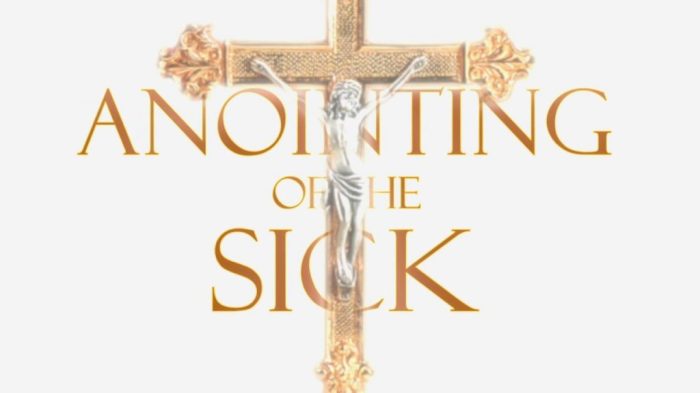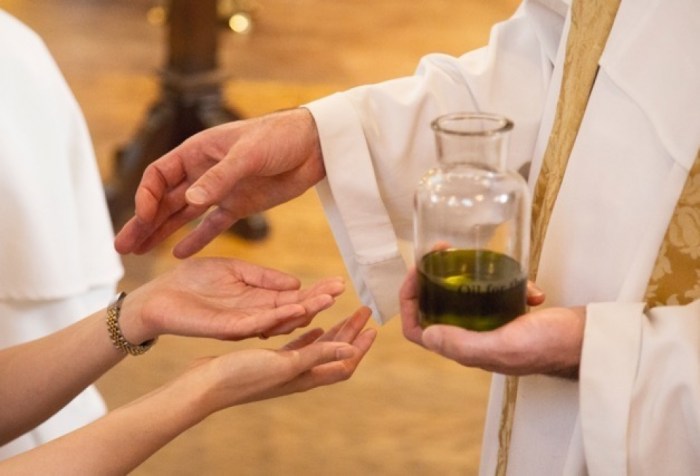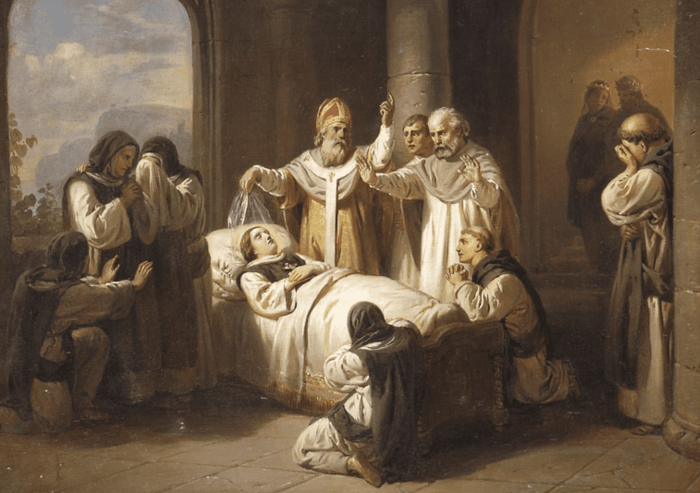Symbols of anointing the sick – Unveiling the profound significance of symbols in the sacrament of anointing the sick, this discourse delves into the biblical foundations, sacramental practices, and the deeply moving meanings behind this sacred act.
Through the lens of symbolism, we explore the transformative power of anointing oil, the role of the priest as a conduit of God’s healing grace, and the profound impact this sacrament has on the spiritual and emotional well-being of the sick.
Biblical Basis

The practice of anointing the sick with oil finds its roots in both the Old and New Testaments of the Bible, serving as a significant symbol of healing and divine intervention.
Symbols of anointing the sick often include oil, water, and light, representing purification, healing, and divine presence. In the painting “Still Life with Iris,” Iris flowers symbolize hope and healing , while the candle represents the light of Christ. These elements come together to create a powerful visual representation of the anointing of the sick, reminding us of the healing power of faith and the presence of God in times of suffering.
Old Testament References, Symbols of anointing the sick
In the Old Testament, anointing with oil was primarily associated with consecration and setting apart individuals or objects for sacred purposes. For instance, in Exodus 30:22-33, God instructed Moses to prepare a holy anointing oil used to consecrate the tabernacle, its furnishings, and the priests who would serve in it.
Additionally, in Leviticus 14:1-32, anointing with oil was prescribed as part of the purification rituals for those who had been afflicted with skin diseases. The oil, in this context, represented God’s healing and cleansing power.
New Testament Teachings
In the New Testament, anointing the sick with oil is explicitly mentioned in James 5:14-15. This passage encourages the elders of the church to anoint the sick with oil in the name of the Lord, accompanied by prayer for their healing and forgiveness of sins.
The anointing with oil in the New Testament is not merely a physical act but carries deep spiritual significance. It represents the presence and power of the Holy Spirit, who brings healing and wholeness to those who are sick or suffering.
Sacramental Practice: Symbols Of Anointing The Sick

The sacrament of anointing the sick, also known as extreme unction, is a Catholic ritual administered to those who are seriously ill or facing death. It is believed to provide spiritual and physical healing, comfort, and forgiveness of sins.The sacrament is administered by a priest, who anoints the sick person with consecrated oil on the forehead and hands.
The oil, known as the oil of the sick, is blessed by the bishop and is believed to be a symbol of God’s healing power.
Role of the Priest
The priest plays a crucial role in administering the sacrament of anointing the sick. He is the one who anoints the sick person with the oil, prays over them, and offers them comfort and support. The priest also helps the sick person to prepare for death, if necessary, and to receive the other sacraments of the Church.
Symbols and Meaning

Anointing the sick involves several symbols that convey profound meanings related to healing and comfort.
Oil
The oil used in the anointing ritual holds significant symbolism. It represents God’s presence, healing power, and compassion. In the Bible, oil is often associated with healing, anointing for special tasks, and as a symbol of the Holy Spirit.
The oil’s soothing and moisturizing properties are also seen as a metaphor for God’s healing touch, providing comfort and relief to the sick.
Laying on of Hands
The laying on of hands is another important symbol in the anointing ritual. This gesture represents the transfer of God’s healing power through the priest or minister. It is a sign of God’s presence and blessing, and a physical expression of prayer and intercession.
The laying on of hands also signifies the community’s support and care for the sick individual, reminding them that they are not alone in their journey towards healing.
Prayer
Prayer is an integral part of the anointing ritual. Through prayer, the priest or minister intercedes for the sick person, asking for God’s healing and comfort. Prayer recognizes that healing is ultimately a gift from God and that human efforts are only part of the process.
The prayers offered during the anointing ritual are often specific to the needs of the sick individual, asking for relief from suffering, strength, and hope.
Anointing Oil

Anointing oil, also known as the Oil of the Sick or the Holy Oil, is a consecrated oil used in the sacrament of Anointing of the Sick. It has a rich history and symbolism in the Christian tradition.
Ingredients
Traditional anointing oil is made from a blend of olive oil and balsam. Olive oil is a natural oil obtained from the fruit of the olive tree and has been used for centuries for its medicinal and symbolic properties.
Balsam, a fragrant resin derived from certain trees, is added to the oil to give it a sweet scent and enhance its medicinal qualities.
Significance of the Olive Tree
The olive tree holds great significance in the Christian tradition. It is often associated with peace, abundance, and healing. In the Bible, the olive tree is mentioned as a symbol of God’s blessing and protection.
The use of olive oil in anointing oil symbolizes the healing and restorative power of God’s grace, which is bestowed upon the sick and suffering.
Preparation and Consecration
Anointing oil is typically prepared by a bishop or priest during a special ceremony. The oil is blessed and consecrated through prayers and invocations, asking God to sanctify the oil and make it a channel of his healing power.
The consecrated oil is then used to anoint the sick and suffering, offering them comfort, strength, and hope in their time of need.
Pastoral Implications

Anointing the sick holds immense significance in pastoral care, offering spiritual and emotional support to those facing illness and suffering.
The sacrament provides a tangible connection to God’s healing presence, reminding individuals that they are not alone in their struggles.
Role in Providing Spiritual Support
Through the anointing with consecrated oil, the sacrament symbolizes the outpouring of God’s grace and healing power. It conveys a sense of comfort and assurance, reminding individuals of their dignity as children of God, even amidst illness.
The prayers and blessings accompanying the anointing express the Church’s concern and support for the sick, offering a sense of community and belonging.
Role in Providing Emotional Support
Anointing the sick can alleviate emotional distress and provide solace during times of vulnerability. The act of being anointed can convey a sense of peace and acceptance, helping individuals cope with the emotional challenges of illness.
The sacrament can also provide a safe space for expressing fears, anxieties, and hopes, fostering a sense of emotional release and healing.
Examples of Comfort and Healing
- A patient experiencing chronic pain finds solace and comfort through the anointing, which provides a sense of peace and reduces their anxiety.
- An elderly person facing a terminal illness receives strength and encouragement from the anointing, which reminds them of God’s presence and eternal hope.
- A child undergoing surgery feels less anxious and more confident after being anointed, which provides a sense of protection and support.
FAQ Insights
What is the biblical basis for anointing the sick?
The practice of anointing the sick finds its roots in the Old Testament, where it was used as a sign of healing and blessing. In the New Testament, Jesus himself anointed the sick with oil and healed them.
What is the significance of the oil used in the sacrament of anointing the sick?
The oil used in the sacrament is a symbol of God’s healing grace. It is blessed by the bishop and consecrated for use in this specific sacrament.
What is the role of the priest in administering the sacrament of anointing the sick?
The priest acts as a mediator between God and the sick person, offering prayers and blessings. He anoints the sick person with oil, invoking the Holy Spirit to bring healing and comfort.